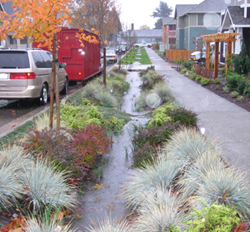Plant-Life and Water Retention
Create a Bioswale
What Is It?

Municipal Research and Services Center of Washington
Bioswales are similar to bio-retention cells and rain gardens but instead channel stormwater into a trough filled with vegetation, compost or mulch, and rubble to reduce runoff, increase infiltration, and remove pollutants. Bioswales are often positioned alongside roads and parking lots to capture runoff. The swale’s side slopes should not exceed 33%, and longitudinal slope should not exceed 4% unless check dams are used to reduce flow velocity. Bioswales typically cost less than traditional curb and gutter systems, though their efficacy is dependent on proper siting, design, and construction, as well as continued maintenance. Moreover, bioswales can be ineffective during and become damaged by large storms, as high velocity flows can overwhelm the swale and erode vegetation. Vegetation used in bioswales should be flood tolerant, erosion resistant, salt tolerant, and native when possible. Bioswales can be used in combination with other stormwater best management practices to manage high stormwater flows.
Regular maintenance is required to ensure continued effectiveness and system longevity, including regular mowing and reseeding, as well as inspections for erosion, weed control, and trash removal. Proper snow and sand removal are necessary to ensure that bioswales continue functioning after winters in cold areas.
Benefits
- Uses natural processes to reduce stormwater runoff volume, rate, and pollutants and increase soil and groundwater infiltration
- Green spaces can improve urban air quality, contribute to lower urban air temperatures, and be aesthetically pleasing
- Can be easily retrofitted during any landscape modification or parking lot/street resurfacing
- Construction and maintenance costs of bio-retention are often lower than those of conventional stormwater management systems
Drawbacks
- Not suitable for heavy stormwater flows. Swales can be overwhelmed by large storms, and vegetation can be eroded by high velocity flows.
- Careful landscaping and maintenance required; poor landscaping and maintenance can result in ineffective drainage and could attract pests
Regulatory Impacts and Requirements
Potential regulatory touchpoints in Boston and Massachusetts include:
- Conservation Commission
- of Environmental Protection
- Boston Water and Sewer Commission
- Boston Groundwater Trust
Financing Options, Incentives, and Rebates
- Municipal stormwater abatement service fees – Municipal-level
- Coastal Pollutant Remediation (CPR) Grant Program – MA State
- Clean Water State Revolving Fund (SRF) – MA State
- Section 319 Nonpoint Source Competitive Grant – Funding provided under federal Clean Water Act
- 604b Water Quality Management Planning Grant – Funding provided under federal Clean Water Act
- Drinking Water Supply Protection Grant Program – MA State
NEWS
- "From Bioswales to Pennycress: How Detroit Neighborhoods Are Going from Grey to Green" Model D, April 2015
- "Meet the Bioswale, New Yorks New Weapon in the War Against Water Pollution" Mother Nature Network, November 2014
RESOURCES
- Soil Science Society of America: Rain Gardens and Bioswales
- US Dept. of Agriculture, Natural Resources Conservation Service: Bioswales
- Boston Society of Architects: Welcoming the Water
PROJECT EXAMPLES
- Chagrin River Watershed Partners Case Study, OH
- East Washington Street in Syracuse, NY
- NYC Green Infrastructure Neighborhood Demonstration Area, NY
- The Steel Yard, RI
A SAMPLE OF PROVIDERS
- Landscape designers/contractors (e.g. Klopfer Martin Design Group, A Yard & A Half Landscaping)
- A list of plants native to Massachusetts coastal environments is available here
- A list of species appropriate for use in bio-retention is available here


